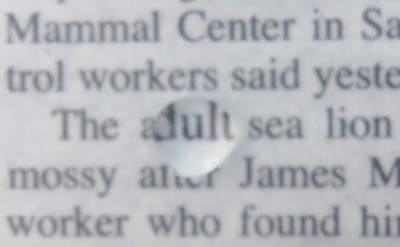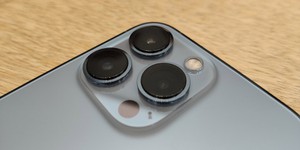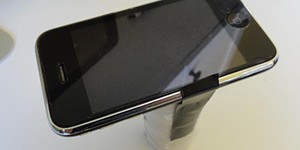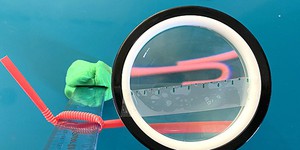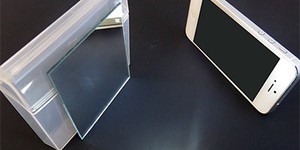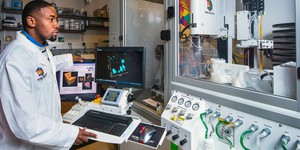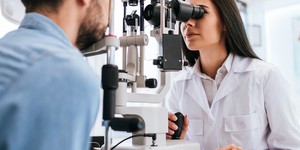Use a Drop of Water as Magnifying Glass
Summary
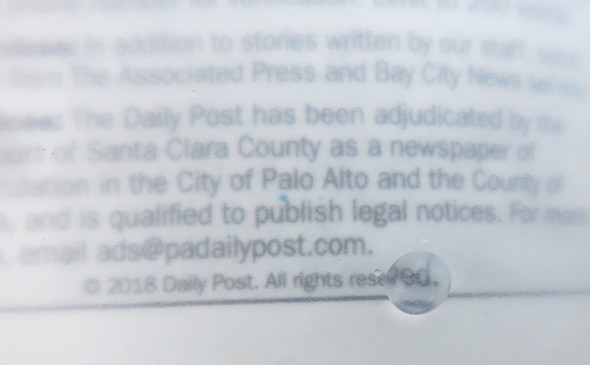 Image Credit: Sabine De Brabandere, Science Buddies / Science Buddies
Image Credit: Sabine De Brabandere, Science Buddies / Science Buddies
Introduction
Are you ready to bend light, magnify letters, and have fun with drops of water—all while getting a glimpse into how lenses work? Lenses are the key components in eyeglasses, contact lenses, binoculars, telescopes, and magnifying glasses, just to name a few devices. With this activity, a homemade magnifying glass is only a drop away!
Materials
- A newspaper page
- Two rulers with metric measurements on them, preferably with dark markings
- One transparency film or clear sheet protector
- Drinking glass with water
- Medicine dropper (optional)
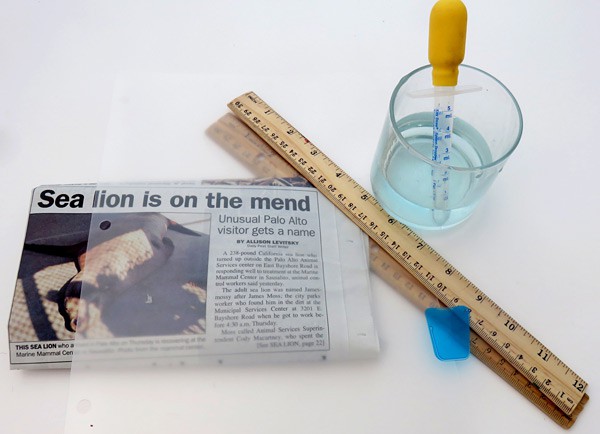 Image Credit: Sabine De Brabandere, Science Buddies / Science Buddies
Image Credit: Sabine De Brabandere, Science Buddies / Science Buddies
Prep Work
- Find a waterproof work area.
- Select an article in the newspaper with a small font. You can use your ruler to measure the height of the letters; they should only be a few millimeters high.
Instructions
- Place a transparency film on top of a newspaper page.
- Create a drop of water near the middle of the transparency film. Use a water dropper or your finger to let two or three drops fall onto the film and merge into one bigger drop. Examine your water drop.Is the top of the drop's surface flat, curved inward, or curved outward?
- Shift your transparency film so the water drop lays on top of the small print letters.
- Close or cover one eye and look from above with the other eye at the letters under the drop.Do the letters covered by the drop appear bigger, smaller, or the same compared to those next to the drop?
- Using two hands, carefully lift and hold the transparency film about half an inch above the newspaper, leaving the newspaper on your work surface. You might need help lifting the transparency film if you prefer to cover one eye with a hand.
- Close or cover one eye and look carefully from above through the water drop at the letters on the newspaper.Do the letters appear different than when the transparency film rested on the newspaper? What happens when you move the transparency film farther up?
- Move the transparency film up and down a couple of times, looking from above through the water drop with one eye.How does your perception of the letters change as you move the transparency film farther up or back down? Why do you think this happens?
- The magnification factor indicates how many times larger than its size the object appears. To measure the magnification factor of your water drop, put a ruler under your transparency film on your work surface and another ruler next to the drop on top of the transparency film, but be sure to prevent the ruler from touching the drop.
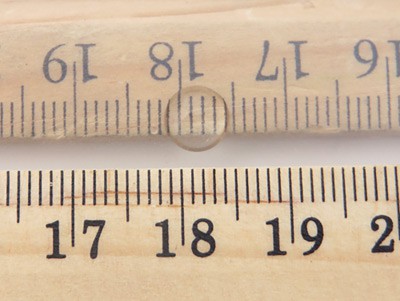 Image Credit: Sabine De Brabandere, Science Buddies / Science Buddies
Image Credit: Sabine De Brabandere, Science Buddies / Science Buddies
- Lift the transparency film with the top ruler and water drop about 1.3 centimeters up and do your best to measure the length of a millimeter indication of the bottom ruler, as seen through the water drop. You might need help lifting the transparency film together with the ruler and the water drop.How many millimeters does one millimeter indication measure? This number tells you by what factor objects appear bigger when seen through your water drop. Are you surprised about the magnification factor you obtained?
- Measure the magnification factor of your water drop when you lift the transparency film higher up.Does the magnification factor change when you lift the transparency higher? Could you find ways to make the magnification factor very big?
- Repeat the activity, this time using a larger water drop.What happens to the curvature of the top surface of the water drop when you increase the size of the drop? Is it more, less, or similarly curved? Do bigger water drops yield a different magnification factor?
What Happened?
To see an object, light rays reflected from the object need to fall into your eye. Light rays usually travel in a straight line to your eye, but things can change when a transparent material, such as glass or water, gets in the way. Did you see how objects appear larger when viewed through a water drop? The surface of a water drop curves outward to make a dome, and this outward, or convex, curvature bends light rays inward. As a result, the object appears bigger than it is.
The surface of a smaller drop is even more curved, bending the light rays even more inward. The result is a larger magnification: the object appears even larger. Changing the position of the water drop with respect to the letters and your eye will also affect how much larger the object appears.
Digging Deeper
You see an object because light rays reflected from the object shine into your eye, creating an image on the retina inside your eye. Signals sent to your brain allow it to recreate the picture of the object.
Although a light ray bouncing off an object usually travels in a straight line to your eye, things change when a transparent material like glass or water gets in the way. When a light ray traveling through air enters such a material, it changes direction, creating a sort of kink. Another kink is introduced when the ray leaves the material. Therefore, the final image of the object in your eye might be different because the light changed direction on its way to your eye. Your brain is unaware of these kinks, and expects an image created by rays that traveled in a straight line. As a result, it might reconstruct a picture that is different from the initial object. Your eyes and brain might have been fooled!
Lenses use these kinks to make objects look bigger or smaller, closer or farther away. A convex or dome-shaped lens bends light rays inward, which results in the object being perceived as larger or closer. A concave lens—a lens that curves inward—bends rays outward, giving the perception that objects are smaller or farther away. There is no overall bending of light for a flat lens; you perceive the object as it is.
A water drop has a dome-shaped surface, and thus, serves as a convex lens. Due to something called the capillary effect, a layer of water in a cup shows a surface that is bent slightly inward. It will act as a concave lens that bends the light rays outward. As a result, letters seen through the layer of water in a cup appear smaller than they are. When you combine several lenses, the magnification factor of the set of lenses is the product of the magnification factors of the individual lenses.
Any clear liquid will work as a lens. As long as the bottom and top surfaces of the layer or drop are not parallel, the lens will change the appearance of the object. Depending on the liquid, the magnification factor of similar drops made up of different liquids will vary.
Ask an Expert
For Further Exploration
- Can you find the optimum water drop size and its height above the newspaper to increase the readability of your chosen newspaper line? Would you choose different conditions if you were investigating the details of an insect? Why or why not?
- Go around the house or the garden looking at objects through your new magnification glass. What kind of surprising details can you find?
- You used a drop of water to create a magnifying glass, making objects appear larger. What do you think would happen if you looked through a bigger layer of water held in a cup? To test this, find a small transparent plastic cup or small drinking glass with a flat bottom. To verify that the cup itself does not act as a lens, place the empty cup over a straight line found in your newspaper, look through the cup, and observe. Does the line appear straight? Does it appear to have the same thickness if you lift the cup? If not, find another cup, because the bottom of this cup already acts as a lens. Once you have a cup that does not act like a lens, fill it with a layer of water (about 1.3 centimeters high) and look from above through the water to the letters on your newspaper. How do the letters appear? Does their appearance change when you move the cup up and down? You might want to shift to a font with larger letters. Can you calculate the magnification factor of this lens?
- Optical instruments often use a combination of several lenses. If you made both the water-drop lens and the cup-with-water lens, observe what happens if you combine both. You can put the transparency on top of your cup and look from above or ask a helper to hold your transparency film with the water drop as you hold the cup above it. Can you measure the magnification factors for both lenses individually (at the exact distance you are holding them when you combine both) and when combined?
- Would other liquids also create magnification? Would one liquid work better than another? Think of oil or vinegar or soy sauce. Which ones do you think might work, and why?
Related Resources
Project Ideas
Activities
Lesson Plans
- MS-PS4-2. Develop and use a model to describe that waves are reflected, absorbed, or transmitted through various materials.


